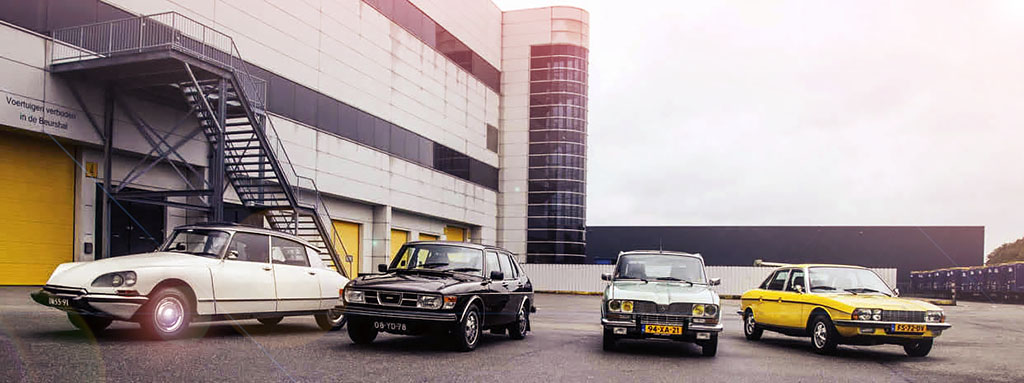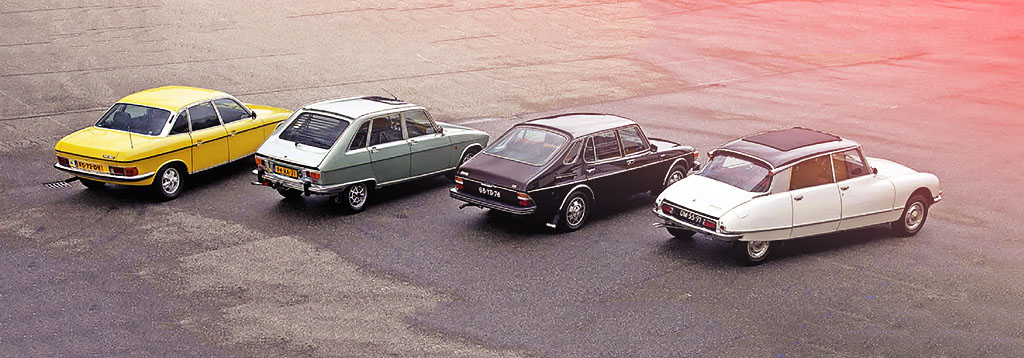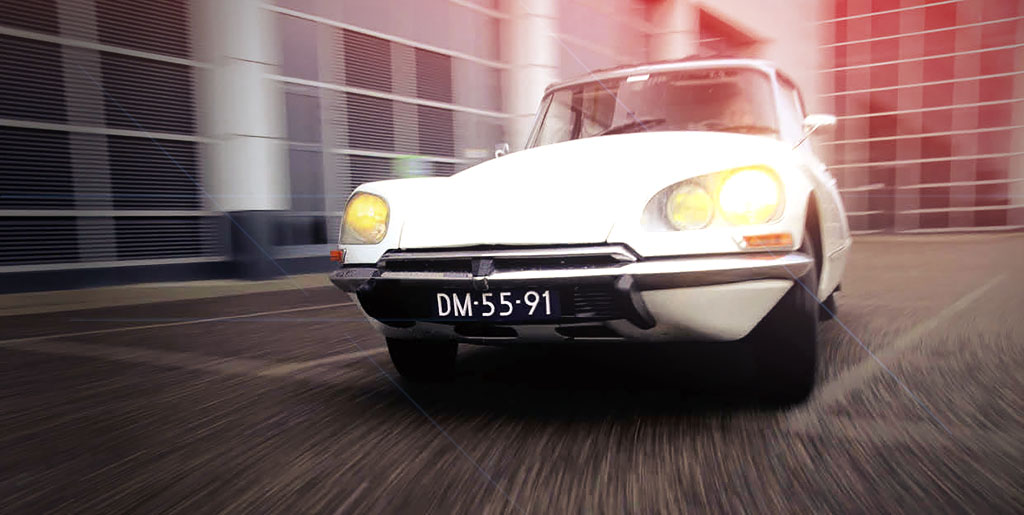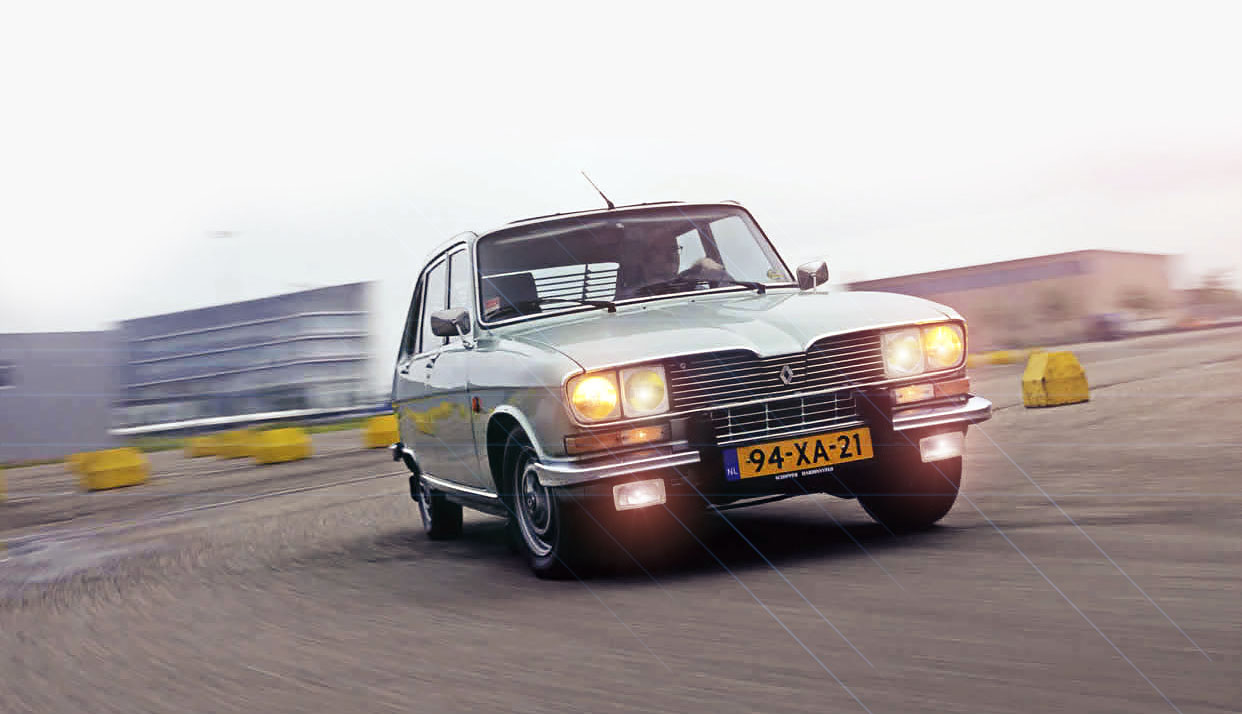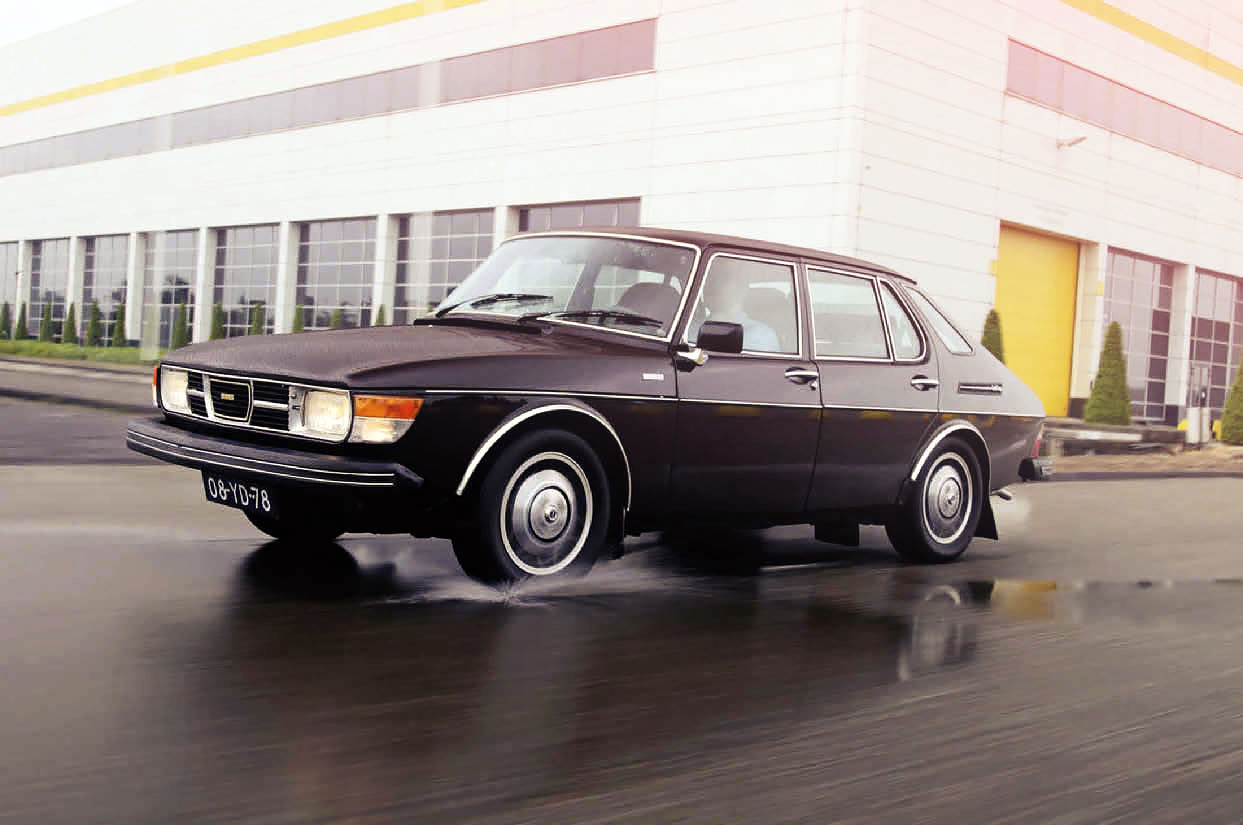Where innovativeness remained who automakers before? The creativity has the fifties and sixties replaced by a collective, partly due to the regulations dictated lack of imagination. Can you remember when we in the auto industry last saw an idea that was actually revolutionary? Well, new cars are of course getting better, safer and cleaner and electric, CO2-neutral mobility does seem to have a future. But whether that’s progress of our times? Not quite. Eventually we drove all power when the engine of the Benz Patent-Car his first puff had to make yet.
When we are asked to name a car that was far ahead of its time, our first thought goes to the beloved Citroën DS. It will probably not have noticed that la Déesse this year the big birthday boy is, exactly sixty years ago, the pike was unveiled at the Paris Motor Show. Because the flocking crowd almost tumbled over each other to catch a glimpse of the extravagant vehicle, Citroën scored during the first day 12,000 orders and had at the end of the show even 80 000 signatures collected in the order book. At a time when the streets are determined by Gray Prewar design, the DS seemed from another solar system originated. And it would remain so until the car twenty (!) years later a replacement in the shape of the Citroen CX.
Leader
Not only the design of Flaminio Bertoni was beyond blurring, even technically DS charged hard with the past. Revolutionary was its hydropneumatic suspension system with level control, that the brakes and stopped the wheelhouse press. It laid the ride comfort is not a single step, but an entire ladder higher. Air-cooled six-cylinder boxer engine one was in development, but lack of money had Citroën revert to the old 1911cc inline-four measuring from the Traction Avant. A big concession, because with its three bearing crankshaft, this engine is anything but modern. Only the cylinder head was adjusted, with hemispherical combustion chambers. The original 1955 Citroen DS19 had a power of 75bhp, enabling a top speed of (at that time not even wrong concepts) 140 kph was within reach.
The DS underwent throughout his career, which only ended in 1975, but twice a facelift. Many modern car designer Bertoni’s unique creation still stand above the personal favourites list. Through technical improvements, added luxury and new, more powerful engines, the DS could continue to compete with the top dance from Germany, Britain and Italy – even without six- or eight-cylinder. In its aftermath, the DS23 engine (M23 Citroen series) received an injection from Bosch (D-Jetronic fuel system), which power was boosted to 141bhp DIN. With a five-speed or an automatic transmission approached the DS23 ie a top speed of 190 kph.
The luxurious Pallas version offers everything the DS enthusiast desires, although the door windows are still hand should be turned down. In 1972 stemming DS Pallas Citroën dealer Henk Visscher (www.visscher.nl) also lacks the popular doctrine, but because it has with red velour interior perhaps even more charming – a Pallas without doctrine to come by. The beautiful, unrestored Pike makes for an incomparable driving experience. Once the engine is running, you can feel the layer lying on the ground car slowly ascend. Sensational to see, but even more beautiful to experience it from behind the wheel. And once on the road, the suppleness of the hydropneumatic suspension continues to amaze on every kind of surface.
The manual five-speed shows with a poker in the steering column serve as the standard H-pattern. Unlike the gas and clutch, you have the brake pedal not normal. The hockey puck on the floor at the slightest touch makes all for an emergency. That first shock, but after a few kilometres scan let the brakes easily and measured dosing. After so many lasting impressions and the motor is almost a disappointment – he’s so normal! The Citroen M23 2.3-liter four-cylinder engine besides excellent performance, let there be no misunderstanding about that. In fact, in this group is the DS even easily the fastest. Yet you expect anything less conventioneels – a jet engine, or possibly drive through nuclear fusion. Something like that.
Fingers
After the DS, the NSU Ro 80 probably in second place in the Top 40 of the most advanced cars of all time. With its streamlined wedge shape had by Claus Luthe signed sedan credible in 1987, strains, but in reality the car appeared twenty years earlier. Even with its innovative twin-rotor Wankel engine 80 Ro ran far ahead of time. Due to the small amount of moving parts, compact design, excellent performance and very civilized and balanced twist properties, many thought that this was the engine of the future. Automakers stood at NSU in line to get a license to the brainchild of Felix Wankel.
But the promise of the Wankel engine began to falter soon. Like the Citroën DS in 1955, the NSU Ro 80 was too early a few years. At the start of production in 1967 still many problems to be solved. Especially the seals of the rotors had a headache, which NSU actually quite quickly got under control. But the damage was done and established the reputation of the car. Whether it is based on truth or not, the story that Ro 80 drivers greeted each other by stabbing on as many fingers as the number of replacement engines in their car, went around like wildfire.
What the demise of the Wankel engine has speeded also was the high gasoline and oil consumption. Both NSU Ro 80 dealers and owners were not used to and influenced by all the negative messages they saw these typical Wankel property as a defect. Even though they were often made in error, the warranty claims piled up so high that NSU is ultimately collapsed. Under the supervision of Audi to the Ro 80 still ten full years of production know.
The teething including the Wankel engine was initially suffering, have long since been corrected. Who handles the Ro 80 as it should, there is a reliable and delicious classic rolling in. That is, moreover, driving experience much less ‘alien’ than at the Citroen DS, even if the automatically coupled with the little head dieback must be switched. The shift knob is a sensor that responds to touch. Once you lay your hand on the button, disconnect the tank. And lost all drive as you relax put your right hand on the poker…
The Ro 80 was particularly special by the way he deceives you with his true age. The absolute new state where our Rally Yellow finds a model – with only 7500 kilometres on the clock (really!) – Is hard to imagine that he has reached the respectable age of 39 years.
But the move puts the Ro 80 calendar twenty years ahead. Its steering responds sharply and does not endorse excessive, the body remains in bends are nice and flat, the chassis has a modern solid alignment and civilized Wankel engine acts as if it wants to compete with modern six cylinder – the Ro 80 does not run at all as a classic!
Smart
In addition to the Citroën DS, we have a jubilee in our midst: the Renault 16. Fifty years ago, this model on the market. The R16 was at his coming not as spectacular as the DS ten years earlier, but with its smart, above the rear-hinged fifth door he put a clear trend. By combining the business look of a classic sedan with the practicality of a station wagon convenient, modern middle-class hatchback was born.
The interior of the R16 was very thoughtfully put together. The seat and backrest of the rear seat could be adjusted in various ways, for the benefit of space or comfort. If necessary you removed the entire back seat, if you needed the entire cargo hold for another transport than passengers with luggage. A low, flat floor was due to the compact rear suspension, wherein the transverse torsion springs one after the other layers. This arrangement explains the deviation in the right and left wheel base: the right-hand rear wheel is seated at the front torsion bar, the left-hand wheel is coupled to the rear spring and is positioned slightly further to the rear.
But of those differing wheelbase right and left mark on your way anything. A few centimetres difference never leave the vehicle suddenly sharper by sending one curve than the other. The Renault 16 is above all a very comfortable touring car, with a supple suspension does and soft chairs. Not something inviting to an enthusiastic driving style, but make no mistake: the R16 is balanced on a winding route or to entice indeed to high speeds. The weight distribution is in fact very favourable. Just as in the DS engine and transmission are located as it were, backwards, in which the largest weight (the motor) is placed behind the front wheels. In a fast GT you could call it a front-mid engine.
In the early years supplied the Renault R16 with just a few spectacular 1.5-liter engine, but to offer the competitive environment, a more powerful engine was soon necessary. With a dual carburettor, larger stroke volume and a five speed gearbox felt the R16 on the highway a lot better at home. The ultimate R16 was presented in 1973: the luxurious TX. This type was ‘strict’ dual headlights, a small wing above the rear window, Gordini wheels and luxury as electric window, central locking, tinted glass and an optional sunroof and leather upholstery. Big advantage was the low weight: the light green 16 TX Wim Schipper late badge see an unladen weight of just 1030 kg. That means far with the other three cars.
Hence, the Renault 16 TX from 1647 cc and 93bhp DIN yet quite know what speed to fleece. From 0 to 100 kmh (0-62MPH) in 12.5 seconds should be possible even imagine the shift mechanism from the steering column thereby secured to the test. But the performance is there and thanks to fifth gear the rpm at cruising speed remains pleasantly low. With the proverbial comfort, space, luxury, performance and fine handling, the Renault 16 TX is a desirable classic.
Prominent
At the time the Renault 16 was unveiled, Saab began to develop the 99. In 1968 a new model on the market and he would – further developed in the Saab 900 – 25 years remain in production. The car earns its spot in this article mainly because of his eccentric character. Saab everywhere held his own ideas about it, resulting in a car that clearly reacted against the masses. With the knowledge had gained in the aviation Sweden in the field of aerodynamics, designer Sixten Sason gave the body of the 99 as a streamlined possible form. In addition to a two and a four-door sedan followed in 1974 the three-door Combi-Coupé in 1976 and the five-door version. Even more than the Renault 16, the brewer Coupés use their practical ability with a maximum load volume of 1,600 liters.
Safety was given a prominent place on the priority list of the developers. The body of the 99 was so strong that for homologation in rallying was not even a roll cage is required. At the wheel was placed a large pillow and the ignition was between the front seats – so that leg injury in a frontal impact could be minimized. Who this location is not used to looking in the first instance an accident to contact. Yet it is curious that Saab’s idea has not been accepted by numerous manufacturers.
Technically, the Saab 99 is very spectacular. The two-litres engine from the 99 GLE Ivan Jansen, is an evolution of the slant-four (four-cylinder tilted) Saab Triumph bought in and by the British engine builder Ricardo showed modify for their own use. Until such time as the production of the 900 ‘Classic’ was discontinued in 1993, Saab remained loyal base engine. The 99 GLE received a Bosch K-Jetronic injection system, which allows the engine kicked it into an output of 118 hp. Many more publicity, the many variants that Saab Turbo is based on this rock-solid machine.
In Ivars 99 GLE engine is mated to an automatic gearbox BorgWarner. It is unfortunate that the bucket is not very subtle change of gear, because a machine fits perfectly with the soothing nature of the car. You sit high and upright behind the wheel lying, which is a very relaxed attitude. The chair is exemplary and can be adjusted in all directions – the tilt function in the seat deserves special mention. Compared to the other three cars, the Saab 99 has a short wheelbase, but the legroom in the rear is surprisingly spacious. You’d rather sit behind the Saab than in the NSU or Renault. Concerning the packaging of its cars Saab also run its own course.
Solutions
It is certainly not a condition, but progressive ideas create a classic extra interesting. For a closer acquaintance with the four cars on these pages, you’ll discover a lot of interesting but often remarkable and complex solutions – which often only used by the authors themselves.
More surprising is that the four eccentric protagonists have all had such a long career; with ten years lasted the career of the NSU Ro 80 still the shortest. For in their drive for innovation were they can easily fail, simply because the buying public was not ready for so much futurism. Meanwhile, all four of them earned a place in the classic world and we can decide which car deserves the most praise.
Thanks to: Henk Visscher (Citroën DS, www.visscher.nl), Mark Hidding, Gert Huiting, NSU Club Netherlands, Pon’s Automobielhandel BV (NSU Ro 80), Wim Schippers (Renault 16), Club d’Anciennes Renault des Pays-Bas and Olav and Ivar Jansen (Saab 99) for their help, expertise and the availability of their cars.
Deliberation
Two of the four cars that are portrayed in this article, I shall possess yourself. For eight years I rode very smoothly around a Renault 16, 1969, my two and a half year relationship was a Saab 99 GL 1982 with more (cylinder) headaches. Both cars I still cherish warm feelings and if I had to choose between the two, I could not decide. The Renault 16 TX Wim Schipper felt like a warm bath, I got in and drove it away as if I never other than R16’ve ridden. The 99 GLE Ivar Jansen was a different experience: with an automatic transmission and power steering the car drove fundamentally different than I remember from my old Saab 99. But it was like coming home: a nice sitting chair, a sweeping view through the panoramic windscreen and a firm yet comfortable chassis.
The Citroen DS has long been the car that I was determined to do, and I am still very impressed by the Pike. Yet now I wouldn’t not even consider – the technique is too complex to me and the price of a nice specimen is way above my budget. The same goes for the NSU Ro 80: a beautiful and impressive car, but due to its special technology, the ‘modern’ handling and the value he is not for me.
Red velvet gives the Saab interior lots of colour. The contact is located between the front seats. The Triumph of technology-based Saab engine is heavily tilted to the right front. The body of the 99 was so strong that for homologation in rallying was not even a roll cage is required.
Buying Tips Saab 99 (1968-1984)
Saabs have a name that they are indestructible. Compared to many cars stabbing in the same period they actually decent. But that does not mean that they are immune to corrosion or defects. Most cars are used for what they were built: sweating it. A Saab 99 with low mileage is a rarity. These are automatically the most expensive cars that are available, but also for cars with more kilometres behind the wheel prices go up slowly. Due to relatively high component prices can unpack a garage visit duration.
Body While the other three cars in this article very carefully for rust should be monitored, to overlook the problem of the Saab 99. In particular, the bottom of the doors and sills are important issues, but the risk of rust in the wheel arch edges (including the trim) the greatest. Check out the suspension of the rear suspension and shock absorbers good (at the front). Under the hood, the sheet metal around the battery should be checked properly. When the Paravan (plate under the windscreen) is rusted, rainwater can enter the interior. A wet carpet says it all …
The rock-solid technique 99 engines go several tons with no problems. Rather, they are the components that are built to go on and around the motor, which give the mind. The same applies to the head gasket and keep in mind that the 99-LPG engine not so much lust. Tinkering with the 99 can here and there some question marks. For example, if the parking brake is on the front wheels, the requires good effect, even if you do him too rarely used due to the blocking function in reverse gear. Check the gearbox for a smooth, crack-free operation.
Parts There are many Saab enthusiasts these parts for the 99 have in the attic, as well as the brand specialists can help you get started in your quest. It must be strange to walk, do not want to find a part. In addition, various components applied in the first Saab 900. One last point: the headlining. Which leaves after a period of time from the plate where it is glued on. The plate can only be removed from the car by pulling out the front or the rear window.
Cautions
Wheel wells behind
Sills, bottom doors
Sagging Headlining
Clubs
Saab Club Netherlands
www.saabclub.nl
Saab Classics Association Netherlands
www.saabclassicsvereniging.nl
Saab Club Belgium VZW-ASBL
www.saabclub.be
TECH SPEC Saab 99 GLE (1977)
Engine: petrol; line four cylinder engine, front built-in in the longitudinal direction; Two valves per cylinder; One overhead camshaft driven by chain; mech. single point injection (Bosch K-Jetronic);
Boring x stroke: 90 x 78 mm; displacement: 1985 cm3;
Compression ratio: 9.2: 1;
Max power: 88 kW / 118 bhp DIN at 5500 rpm;
Max torque: 167 Nm at 3700 rpm;
Transmission: three-speed automatic (selector lever on floor); front wheel drive.
Body – chassis monocoque body steel, five doors;
Suspension
Front: double wishbones, coil springs, telescopic shock absorbers, stabilizer;
Rear rigid axle with drawn wishbone, Panhard rod, coil springs, telescopic shock absorbers; rack and pinion steering, ratified;
Brakes F / R: discs; drums / f/r: 165 SR 15; wheels f/r: 5 J x 15.
Specifications L / W / H: 4521/1690 / one thousand four hundred thirty-eight mm; wheelbase: 2474 mm; track width v / a: 1392 / 1405 mm;
Empty weight: 1220 kg; max. allowable weight: 1700 kg;
Fuel tank capacity: 55 litres;
Built from 1969 to 1984;
Production number: 588 643 (all 99’s).
Performance:
Acceleration 0-100 kmh (0-62 MPH): approx 13.0 sec .;
Top speed: 174 kmh;
Fuel consumption: 10,8 litres / 100 km (1: 9.3)
Of those differing wheelbase left and right you notice the move nothing.
Buying Tips Renault 16 (1965-1980)
There are 15 years nearly 1.9 million R16’s built, but the automobile is only a small group of fanatical enthusiasts has become a coveted collector’s item. It expresses the value: for the price of a good Citroen DS buy now three R16’s excellent – if you find at least one, because the supply is limited. Because many R16-lovers are so fanatical, parts supply is no problem. Certain components are now rare or no longer available, but with some modifications it takes little effort to keep driving a car.
Structural Bodywork corrosion is the biggest Achilles heel of the Renault 16. Many panels are composed of several sheets between rust (often invisible) is rampant. Very important is the state of the sills and box sections, especially around the mounting of the rear axle. The screens (inside and outside) and the A-pillars are rusting sensitive, given freely all over spray water and road debris. Walk all folded joints of the doors, bonnet and tailgate after and see the bottom edge of the front and rear panel.
Motor R16 technique is almost indestructible. Although the head gasket is quite sensitive, but essentially an engine has several tons can go before overhaul is necessary. The 1.6-liter engine (from 1968) is better suited to long rides in modern traffic than the old 1.5 engine, which runs very much speed. Nor the gearbox causes problems, at most, the switching mechanism can by too much play whatever struggle. Another focus: the drive shafts with open joints of the older models.
Parts For parts you can also count on several addresses in the Netherlands. Centre 16 in IJmuiden and the Renault 16 Club Tilburg (www.renault16.com) have a wide range. All is not available anymore, but before conceived solutions. Also note the condition of the tires: Some dimensions are hard to find.
Cautions
Tube beams at rear mounting
Front fenders, inside and outside
Drive shafts, wheel bearings
Clubs
Club d’Anciennes Renault des Pays-Bas
www.renault-klassiek.nl
CAR Belgique & Alpine Club de Belgique
www.carbel-acb.be
The Renault 16 TX is very luxurious, with leather upholstery and electric window. R4 solution in the large: the gearbox is before the motor.
TECH SPEC Renault 16 TX (1978)
Engine: petrol; line four cylinder engine, in front longitudinal direction built-in;
Two valves per cylinder; 1 centrally positioned camshaft driven by chain;
One twin carburettor (Weber DAR7 32);
Boring x stroke: 79 x 94 mm;
Displacement: 1 647 cm3;
Compression ratio: 9.25: 1;
Max power 68.4 kW / 93bhp DIN at 6000 rpm;
Max torque: 128.5 Nm at 4000 rpm;
Transmission: five-speed manual transmission (control circuit); front wheel drive.
Body – chassis monocoque body steel, five doors;
Suspension:
Front: double wishbones, torsion springs, telescopic shock absorbers, stabilizer;
Rear: independent freelancers. suspension with drawn support arms, torsion springs, telescopic shock absorbers, stabilizer;
Steering: rack and pinion
Brakes F / R: Disc / drums;
Tyres: F / R: 155 x 14;
Wheels F / R: steel
Specifications L / W / H: 4237/1628 / 1460 mm;
Wheelbase left / right: 2650/2715 mm;
Track F / R: 1342/1292 mm;
Empty weight: 1030kg;
Maximum trailer weight: 1490 kg.
Fuel tank capacity: 50 litres
Built from 1965 to 1980,
Production number: 1,845,959 (all R16’s).
Performance Acceleration 0-100 kmh (0-62MPH): approx 12.5 sec .;
Top speed: 170 kmh;
Fuel consumption: approximately 10.0 litres / 100 km (1: 10.0).
German pragmatism: the dashboard of the Ro 80 is straightforward. Somewhere among all tubes and hoses compact Wankel engine is hidden. The Ro 80 was special because of the way he deceives you with his true age. The set of the clock twenty years ahead.
Buying Tips NSU Ro 80 (1967-1977)
Owners of the best Ro 80’s do rarely away from their car. Therefore, finding a copy in top condition mainly a matter of patience. Most cars are for sale, provide room for improvement. One advantage is that the Ro 80 has hardly changed during his ten-year career; you have to watch for parts rarely in the year of the car. More benefits: the technical expertise within NSU circles is huge and the supply of parts is excellent. If technology exists in a healthy condition, the Ro 80 is a very reliable car.
Body To inspect the underside, a lift is desirable. Check the front longitudinal carriers over the entire length, around the suspension of the anti-roll bar, and the water drainage during cornering at the drive shafts. The front panel rust between the fog lamps and the wheel arches and at the radiator support. The upper mounting points of the shock absorbers consist of a double plate, which might exacerbate corrosion. Then view the sills and the surrounding steel is good, even with the jack stands. Remove the seat from the back seat and watch the underlying panel. In the trunk connection of the floor with the wheel arches is a concern.
Finally, the doors. The insulating material retains moisture and drainage is often clogged. Especially along the lower edge of the doors are susceptible to corrosion.
A technique well maintained Ro 80 is a reliable vehicle. This also applies to the motor, although the housing and the seals however are subject to wear. But the Ro-80 engine has no problem thick 100 000 kilometres on it. Knowledge of the art is a requirement for a check condition, let it is preferably to an expert on. A quick motor control: trap the brake and give full throttle in first gear. For a good motor, the speed increases to 2000 to 2200 rpm. This is less: the engine is worn out. Is it more: the clutch slips. For a compression measurement Special tools are required.
Parts The Dutch NSU club is a series known addresses of (mainly) hobbyists who can help the Ro-80 owner to find the necessary parts. New sheet metal is rare, a good second-hand door has become very expensive.
Cautions
Upper mounting points shock absorbers
Doors
Seal rotor crashed
Clubs
NSU Club Netherlands
www.nsu.nl
NSU Club Belgium
www.nsu.be
Ro 80 Club International ff
www.ro80club.org
TECH SPEC NSU Ro 80 (1976)
Engine petrol; twin-rotary engine, front built-in in the longitudinal direction;
One twin carburettor (Solex 32 DDITS);
Room volume: 2 x 497.5 cm3;
Compression ratio: 9.0: 1
Max power: 84.6 kW / 115bhp DIN at 5500 rpm;
Max torque: 162 Nm at 4500 rpm;
Transmission torque automatic transmission with manual driebak (floor poker); front wheel drive.
Body – chassis monocoque body all steel, four doors;
Suspension:
Front McPherson struts with rubber auxiliary springs, control arms, stabilizer; A: independent freelancers.
Rear suspension drawn with supporting arms, coil springs, rubber auxiliary springs, telescopic shock absorbers, stabilizer;
Steering: rack & pinion ratified;
Brakes F / R: discs power-assisted;
Tyres F / R: 175 HR 14;
Wheels F / R: 5 J x 14.
Specifications L / W / H: 4780/1760 / 1,410 mm;
Wheelbase: 2860 mm;
Track width F / R: 1480 / 1434 mm;
Empty weight: 1290 kg; max.
Allowable weight: 1740 kg;
Fuel tank capacity: 83 litres;
Built from 1967 to 1977;
Production number: 37 402.
Performance
Acceleration 0-100 kmh (0-62 MPH): 14.2 sec
Top speed: 180 kmh;
Fuel consumption: approximately 17.4 litres / 100 km (1: 5.7).
You feel the car take off. Sensational to see, but even more beautiful to experience it from behind the wheel.
Buying Tips Citroën DS (1955-1975)
The Citroen DS was less than twenty years in production and quickly grew into an enthusiast’s car. According to many it is the most beautiful car ever – many car designer has Snoek are in his top five. The Netherlands is a DS-country par excellence, even Japanese and French people come to buy their cars to many specialists in our country. The prices are currently in the elevator, which makes restoration of financial point of view interesting again. Due to the long duration of the car is the choice of all bodywork, executive and motor variants extensive. But stay alert, because a bad bargain is quickly committed.
All loose plate body parts (doors, valves, screens) are screwed and can be easily removed – or replaced because they can rust! When the rust of a structural nature is, there are bigger problems. Leave at least one expert judge how the state of the sills around the base of the A-, B- and C-pillars, the crossbar at the front of the boot, the crossmember behind the spare wheel (front) and the bulkhead base of the windshield. The inner fencing and boulders catching his infamous rust nests.
In engineering terms, the motor DS known as robust. At a higher mileage may play the head gasket can partitions, as a result of a slight sagging of the wet cylinder liners. Please note that traces of oil in the cooling water and a white sludge on the inside of the oil filler cap. After starting the engine reaches the hydraulic system pressure, the car is pretty fast should elevate to normal ride height. The hydraulic fluid should be replaced every two years. When the suspension suppleness fog, must look at the spring bulbs. Components The DS is a popular classic and thus attractive for commerce. In the Netherlands, many specialists who can provide virtually anything yet. The club also has an ample supply. For some components may need a little longer to be found, original stainless sheet metal is becoming increasingly rare example. This also applies to certain parts of specific years of construction, such as a water pump 1956/1957 or a bonnet or a screen for a vehicle in 1966/1967. But in general holds: no problem.
Cautions
Sills at A- and C-pillars
Crossmember behind rear
Head Gasket Problems
Clubs
Citroën ID / DS Club Netherlands
www.citroeniddsclub.nl
DS SM Club Belgium
www.dssmclub.be
Citroen DS / ID general Drive-My club
Soft springs, soft chairs – no car as comfortable as the DS. The DS has always had a four cylinder.
TECH SPEC Citroen DS23 Pallas i.e., (1972-1975 spec)
Engine: M23 petrol; line four cylinder engine, in front longitudinal direction built-in;
Two valves per cylinder; 1 centrally positioned camshaft driven by chain; electronic single point injection (Bosch D-Jetronic);
Bore x stroke: 93.5 x 85.5 mm;
Displacement: 2347 cm3;
Compression ratio: 8.75: 1;
Max power 105 kW / 141bhp DIN at 5750 rpm;
Max torque: 195 Nm at 4000 rpm;
Transmission: five-speed manual Citroen or C-Matic 3-speed semiautomatic, or Borg-Warner 3-speed full automatic hydro (control circuit); front wheels drive.
Body – chassis combined integrated platform

